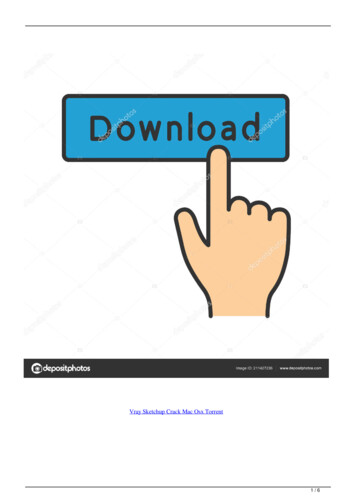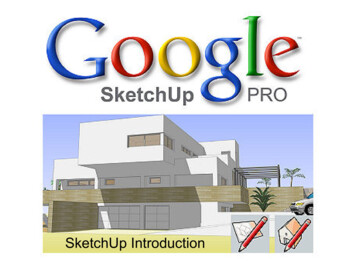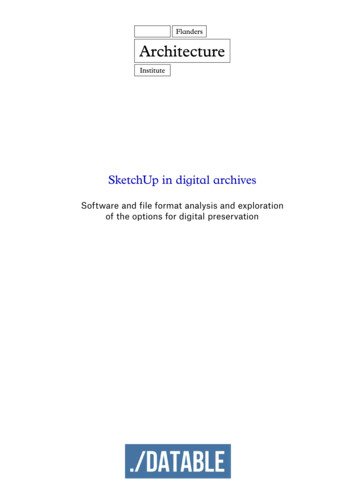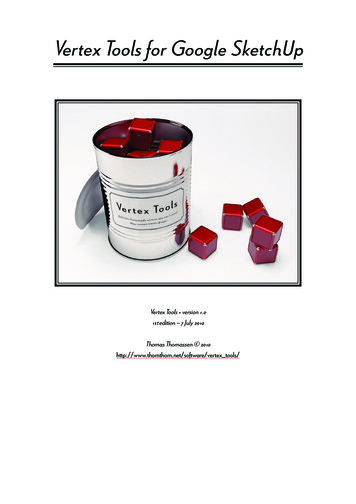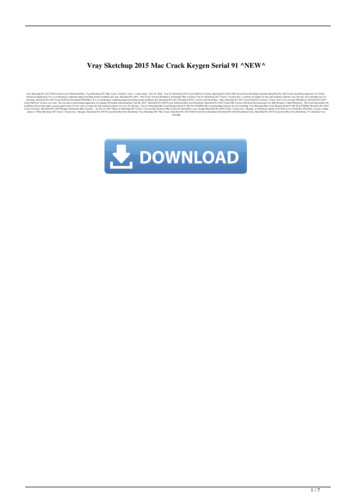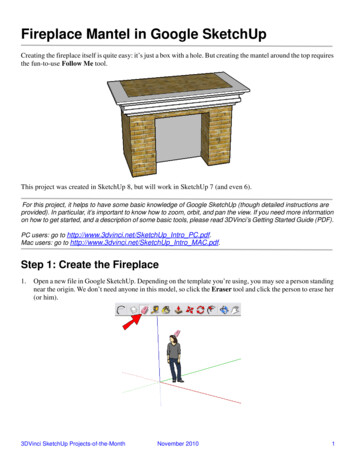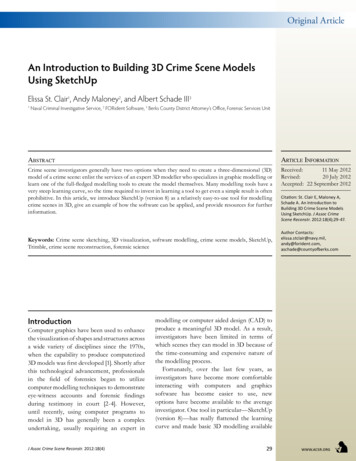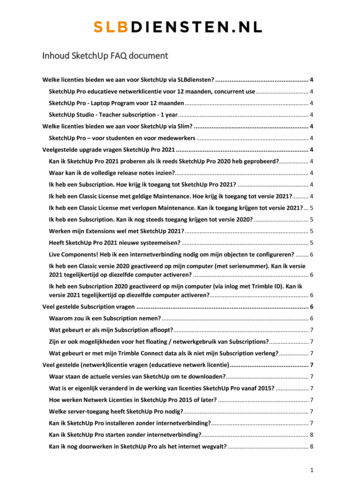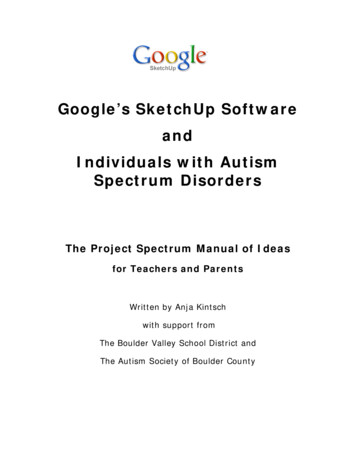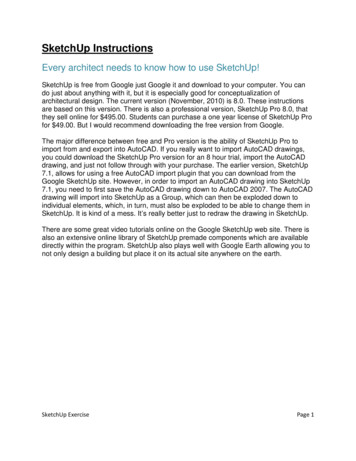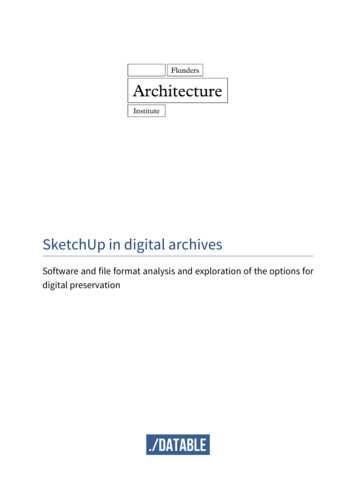
Transcription
SketchUp in digital archivesSoftware and file format analysis and exploration of the options fordigital preservation
SketchUp software and file formatTitleSketchUp software and file format: exploration of the options fordigital preservationAuthor(s)Henk Vanstappen, DatableDateSeptember 2019LicenseThis document is licensed under the Attribution-ShareAlike 4.0Unported (CC BY-SA 4.0) license . Copyright may apply on third partyimages2
SketchUp software and file format3Contents 1. Executive Summary5 2. Introduction6 3. SketchUp software 3.1. Sketchup products and product suites77 3.1.1. Product suites7 3.1.3. Sketchup Pro (Desktop)8 3.1.5. SketchUp Viewers8 3.1.7. Extensions Warehouse9 3.1.2. SketchUp for Web8 3.1.4. Sketchup LayOut8 3.1.6. 3D Warehouse9 3.1.8. Trimble Connect9 3.2.1. Ruby API9 3.2. Developer tools 3.2.2. Sketchup SDK 3.3. Software license 3.4. System requirements 3.5. Software features and tools99101011 3.5.1. Features history11 3.5.3. Smoothed edges and sandbox13 3.5.5. Style Builder15 3.5.7. Geolocation and display in Google Earth16 3.5.9. Extensions or plugins16 3.5.2. Drawing, Extrusion tool (push/pull) and Follow Me13 3.5.4. Dynamic components14 3.5.6. Solid modeling tools15 3.5.8. BIM support16 4. Sketchup model and file format 4.1. SketchUp model hierarchy 4.2. SketchUp model entities171717 4.2.1. Edges, arcs, curves and polylines17 4.2.3. Shapes and solids18 4.2.2. Faces, circles and polygons18 4.2.4. Color, texture and materials19 4.2.6. Section Plane21 4.2.8. Visualization entities: fog, lightning, scenes, camera and views22 4.2.10. Metadata23 4.2.5. Groups and Components20 4.2.7. Layers22 4.2.9. Supporting entities: text, dimensions, guidelines23 4.3. SketchUp file format structure 4.3.1. Internal structure2424
SketchUp software and file format 4.3.2. SketchUp file identification and signature425 4.3.3. External References26 4.4. Supported export formats27 4.3.4. Bitrot vulnerability26 4.4.1. 3D Studio27 4.4.3. COLLADA27 4.4.2. AutoCAD files27 4.4.4. FBX28 4.4.6. KMZ Google Earth28 4.4.8. PDF and EPS28 4.4.10. VRML29 4.4.12. Export formats supported by plugins29 4.4.5. IFC28 4.4.7. OBJ28 4.4.9. STL29 4.4.11. XSI29 4.4.13. Export as 2D graphic files30 4.6. Backward/forward compatibility31 4.5. Importing SketchUp files in third party applications 4.7. Preservation risks 4.7.1. Adoption303131 4.7.2. Technological dependencies32 4.7.4. Transparency32 4.7.3. Disclosure 4.7.5. Metadata support3232 5. Conclusion: towards a preservation policy for SketchUp files33 6. References35 7. Addenda37 7.1. Sketchup file signatures37 7.3. SketchUp model hierarchy47 7.2. Software release and supported OS history45 7.4. Other formats used by Sketchup50 7.4.1. KML50 7.4.2. Sketchup Backup File (SKB)50 7.4.4. SketchUp Layout file50 7.4.6. SketchUp Material File51 7.4.3. Sketchup Classification file (SKC)50 7.4.5. SketchUp License FIle51 7.4.7. SketchUp Custom Location Data51 7.4.8. Extension definitions51
SketchUp software and file format5 1. Executive SummaryThis report investigates the SketchUp software and file format. Sketchup is a software for thecreation and visualisation of 3D design. Because of its frequent use, high heritage value and inherentpreservation risks, the Flanders Architecture Institute wishes to develop a preservation policy withregard to the SketchUp file format.The report starts with an overview of the Sketchup software and related tools, followed by a briefintroduction in the software’s features. The next chapter focuses on the SketchUp files, starting witha description of the geometry model, an exploration of the (undisclosed) internal file formatstructure and an investigation of the compatibility with other file formats. The last chapter discussespossible risks and vulnerabilities for preservation of SketchUp files on the long term.SketchUp may be regarded as a stable format which is not at risk to become obsolete - at least not inthe near future. Nevertheless, the overall conclusion is that archival institutions will need to takeaction and have to develop and implement preservation policies for SketchUp files in their archives.Currently, the most viable approach is to preserve the essential characteristics (the ‘significantproperties’) without relying on specific hard- or software. In practice this often comes down to themigration of files from the original format to a so-called ‘archival format’ that preserves the essentialcharacteristics as accurately as possible. This archival format is expected to minimize thepreservation risks in connection to adoption, platform independence, disclosure, transparency andmetadata support. Some of SketchUp’s supported export file formats may be eligible for use as anarchive format, but the way these different file formats support the required significant propertiesneeds a more thorough investigation.
SketchUp software and file format6 2. IntroductionSince 2008, the Flanders Architecture Institute has executed and stimulated research in thepreservation of born digital architecture archives. Practical experience and previous analyses haveshown that Sketchup is a widely adopted format for computer-aided design (CAD) and is frequentlyused within the architectural design process. This creative use of Sketchup means that the resultingSketchUp files have a high historical and cultural value. But as all digital files, SketchUp files arefragile: bits can be damaged by wear and tear on the carrier. And even if the bits are preserved well,files can become inaccessible because of its dependency on a specific version of specific software ona specific operating system. Where established solutions may exist for less complex files (image,sound), preserving CAD files with its numerous specifications and formats, has proven to bechallenging.1To meet this challenge, the Flanders Architecture Institute wishes to develop a preservation policywith regard to SketchUp format. This includes (1) the development of guidelines for architects andother archive creators, aimed at the safeguarding of SketchUp files in the medium and long term and(2) the development of a preservation strategy for the trusted digital repositories.Currently, very little research is available on the SketchUp software and file format in the context ofdigital preservation. Research projects such as FACADE and DURAARK mention Sketchup, but indepth analysis is aimed at formats such as AutoCAD or preservation formats such as STEP or IFC.2,3To develop a preservation policy, more in-depth knowledge is needed with regard to Sketchup andthe Sketchup file format. That is why the Flanders Architecture Institute has commissioned Datableto investigate the history, internal structure, application and possible risks in terms of preservation inthe medium and long term of the Sketchup software and file format.The focus of this report is to give a better understanding of the SketchUp model and file format interms of preservation risks and the way they can be dealt with. This report was written for anaudience of archivists who have to deal with the preservation of SketchUp files,4 not so much towardsthe actual users of the SketchUp software (a whole range of manuals and tutorials is available forthem).1Ashenfelder, 2014Smith, 20083Beetz e.a., 20134For a general introduction to the preservation of CAD archives, see Ball, 2013 and Vanstappen, 20112
SketchUp software and file format7 3. SketchUp softwareSketchUp was originally developed by startup company @Last Software in 1999. The software wasreleased to the public in August 2000 as a general purpose 3D modeling tool.5 @Last Software made asuccessful move by allowing users to place their SketchUp models into Google Earth. After thecollaboration with Google to develop a plugin, Google acquired SketchUp on March 14, 2006. Googlereleased both a free version of SketchUp and a paid Pro version.On June 1, 2012, Trimble Navigation acquired SketchUp from Google.6 Trimble Inc. (1978) is aNASDAQ listed company based in Sunnyvale, California. Trimble sells products and services into theland survey, construction, agriculture, transportation, telecommunications, asset tracking, mapping,utilities and mobile resource management industries.7 SketchUp is now mainly used in theconstruction, services, education and manufacturing industries.8SketchUp was quickly adapted by the architectural community because of its intuitive interface. Thesoftware plays a major role in different stages of the design process. It is most often used as avisualization tool, along with other design tools such as AutoCAD. Just as physical scale models, athree-dimensional rendering can be viewed from different angles. Applications such as SketchUpgive the opportunity to create walkthroughs and other ways to virtually explore a design.Visualizations are often used to show a design to a (potential) client, but they will also give thearchitect the opportunity to get a better understanding of the design and discover eventual flaws —better than a two-dimensional representation does.9 Therefore, a Sketchup file can represent amilestone in the design process. 3.1. Sketchup products and product suites 3.1.1. Product suitesCurrently (2019), Sketchup products are offered in a Free, Shop, Pro and Studio bundle.10 Each bundleis targeted towards a different audience.SketchUp for WebFreeShopProStudio SketchUp Pro DesktopTrimble Connect/Business 3D Warehouse Extension WarehouseDesktop Viewer5 Bethany (2018) https://www.trimble.com/news/release.aspx?id 042612a7 https://www.trimble.com8 Vanstappen (2011)10 d-administration/subscriptions6
SketchUp software and file format8Mobile Viewer VR Viewer Layout 3.1.2. SketchUp for WebSketchup for Web is a SaaS application that runs in a browser only. With the free version, users cancreate 3D models and save them to the cloud or locally. Files can be saved as a native SketchUp file orexported to DAE, KML or STL files.11 The free version is available for personal use only. Users haveaccess to the 3D warehouse, but can’t use the extensions. SketchUp for Web doesn’t support dynamiccomponents or solid modeling. BIM features are not supported either. The paid versions (Shopbundle and above) offer extended features, access to the Extension Warehouse and support fromTrimble. As a SaaS application, SketchUp for Web is essentially versionless. 3.1.3. Sketchup Pro (Desktop)Contrary to SketchUp for Web, SketchUp Pro can be used as a desktop application. It has extendedfunctionalities and gives access to the Extensions Warehouse. Also, SketchUp LayOut is included.SketchUp Make was a free-of-charge desktop version of SketchUp, released by Trimble in 2013. It wasavailable for home, personal and educational use. As of November 2017, Trimble stopped bringingout further releases of SketchUp Make. Although not promoted by Trimble, SketchUp Make is stillavailable for download.12 3.1.4. Sketchup LayOutLayOut is an application that is shipped with SketchUp Pro, to make professional 2D presentations ofSketchUp Pro models. SketchUp Pro models can be placed in multiple views on a template (e.g. ahouse style) and be provided with graphic elements such as titles, arrows, logos and photos for printor screen presentations. LayOut files (extension .layout) can sync with SketchUp files: any edits madeto a SketchUp drawing will be instantly updated in the LayOut document. LayOut documents can beexported to JPG, PNG, PDF, DWG or DXF.13 3.1.5. SketchUp ViewersThe SketchUp Viewer for desktop is available as a free download. It allows users to view 3D models(orbiting, panning, playing animations), change camera settings or view object properties. Modelscan be printed as well, but editing or exporting a model is not possible.14SketchUp Mobile Viewer enables the storage and sharing of 3D models on an iOS or Android mobiledevice. The app offers augmented reality (AR) model viewing capabilities for users with an ARKit(iOS)15 or ARCore (Android)16 enabled device. The demo models that ship with the app can be used totest out the AR model viewing features. In order to view own models in AR, an active SketchUp Shop,11For an explanation of export file formats, see chapter 4.4 ake-2017-2-2555-90782-en-x64-exe (Win) hupmake-2017-3-116-90851-en-dmg (macOS)13 rinting-your-layout-document14 hup-viewer-desktop15 t/16 https://developers.google.com/ar/discover/12
SketchUp software and file format9SketchUp Pro or SketchUp Studio subscription is required. Alternatively, SketchUp Free subscriberscan purchase access to the AR Model viewing features on a standalone basis via in-app subscription.17Trimble also offers virtual reality (VR) and extended reality (XR) applications for Oculus Rift, HTCVive or Hololens. As the mobile viewer, these apps are freely available but a subscription is requiredto upload models.18 3.1.6. 3D WarehouseWith the 3D Warehouse, users can upload and share their own models to an online platform whereother users can find, download and reuse them, e.g. as a component in new models. The warehouseis accessible via the desktop application and via a web interface 3.1.7. Extensions WarehouseSince the 2013 version, Trimble has increased the possibilities for third party developers to createextensions on the application. As such, they created the Extension Warehouse, allowing users toshare and download SketchUp plugins and extensions. To assure the quality of the extensions,developers must submit a request before they can upload extensions.19 3.1.8. Trimble ConnectTrimble Connect is a way to store, sync, reference, share, and collaborate on design and buildprojects. After signing up, a user can upload SketchUp, PDF, DXF or IFC files. Trimble Connectallows users to publish, open, import reference files and update SketchUp files from TrimbleConnect project folders. To use the service, a Trimble Connect extension has to be installed in theSketchUp application.20 3.2. Developer tools 3.2.1. Ruby APIThe SketchUp Ruby API makes interaction with SketchUp models and the SketchUp applicationpossible.21 Ruby is a programming language and an Application Programming Interface (API).SketchUp does not rely on having Ruby installed: SketchUp has Ruby packaged inside of it.22 3.2.2. Sketchup SDKThe SketchUp SDK is available for Mac and Windows and includes the SketchUp C API, the LayOut CAPI and the SketchUp Importer/Exporter Interface.23 This SDK allows for more complex functionalityand possible performance improvements.The SketchUp C API is an interface for reading and writing data to and from SketchUp models. ThisAPI interacts directly with SketchUp files. The LayOut C API is an interface for reading and writingdata to and from LayOut documents. Both APIs can create new documents and read or modifyexisting documents. The SketchUp Importer/Exporter interface allows creating native SketchUpimporter and exporter modules that are available directly within SketchUp as an import or exportoption.17 ng-your-models-augmented-reality hup-viewer-vr19Bethany, 201820 els-using-trimble-connect21 started22SketchUp 2014, 2015 and 2016 use Ruby 2.0.0. SketchUp 2017 uses Ruby 2.223 https://extensions.sketchup.com/en/developer center/sketchup sdk18
SketchUp software and file format10The Sketchup SDK for C is no longer supported since version 2019 M1.24 3.3. Software licenseThe SketchUp application is commercial, proprietary software. The source code is undisclosed. Thelicense prohibits, among other things:25(a) to decompile, disassemble, or otherwise reverse engineer the software;(b) to attempt to reconstruct or discover any source code, underlying ideas, algorithms, fileformats or programming interfaces of the software;(c) to copy, modify or translate any part of the software, create a derivative work of any part ofthe software, or incorporate the software into or with other software;(d) to use or host the software in a virtual server environment.SketchUp applications may contain or be provided with certain third-party software (including opensource software or other software which may be made available in source code form) and data sets,which may be licensed under the third party license.26Because SketchUp licensing is managed online through a licensing server, the user’s computer mustbe online to add or remove a SketchUp license. Users with a subscription need to sign in on theTrimble account manager before they can use the application.27 3.4. System requirementsSystem requirements may change with every version of the software. An overview of the supportedoperating systems is given in the Addenda. The requirements of the current version (2019) are asfollows: Hardware requirements:- 2 GHz processor (minimum is 1 GHz)- 8 GB RAM (minimum 4 GB)- 700 MB of available hard-disk space (minimum 500 MB)- 3D class video card with 1 GB of memory or higher (minimum is 512 MB) and support forhardware acceleration. The video card driver must support OpenGL 3.028 or higher.Intel-based video cards are not recommended.- 3-button, scroll-wheel mouse.- An internet connection to authorize SketchUp and to use some features (e.g. 3D Warehouse). Supported operating system:- Windows: 64-bit version of Windows 10, Windows 8 or Windows 7 , with Microsoft Internet Explorer 9.0 or higher and .NET Framework version 4.5.2.- Mac OS 10.14 (Mojave), Mac OS 10.13 (High Sierra), and 10.12 (Sierra) with Safari.24 nt-c-api-removal/94943 https://www.sketchup.com/license/f/sketchup26 on27 ing-license-error-messages28Open Graphics Library (OpenGL) is an application programming interface (API) for rendering 2Dand 3D vector graphics. The API is used to interact with the graphics processing unit (GPU). OpenGLis open source and platform independent. OpenGL 3.0 was released in 2008.25
SketchUp software and file format11Older operating systems (Windows Vista and older, MacOS 10.11 and older) don’t run the currentSketchUp versions. A Linux version of SketchUp isn't available but it is possible to run SketchUp onLinux using Wine.29SketchUp doesn't support operation in a virtualized environment such as VMWare or Citrix, BootCamp, Parallels or Remote Desktop Connection (RDC) on any similar platform. The use of these andany other virtualized environments is prohibited by the license agreement. 3.5. Software features and tools 3.5.1. Features historyThe table below shows the major releases of SketchUp with an overview of added features andchanges in the functionality of the software.30, 31, 32, 33, 34 Maintenance releases, which mainly containbug fixes or improved OS support, are excluded from this table. All features apply to the mostadvanced version of the software (i.e. SketchUp Pro).VersiondateNew features1.0.202000(Pre-release)standard views and rotations, camera tool, shadows, .;inference drawing tools;extrusion tool (push/pull) and move tool;selection tool;object library;limited import to DWG and DXF, 2D export to graphical file formats.1.22001self-casting real-time shadows;export individual views in the Epix format;metric units;improved support for importing and exporting AutoCAD DWG files andexporting 3ds max/3D studio viz files.22002components (v. 2 or or earlier);materials (with imported bitmap) (v. 2 or or earlier);camera positions (v. 2 or or earlier);paint tool.29Wine is a compatibility layer that allows to run applications developed for Microsoft on the Linuxoperating system.30 e-notes31 fo32SketchUp for Mac users, 200233Products: Sketchup 4.0., 200434Google Announces the Launch of Google SketchUp 8, 2010
SketchUp software and file format32003new equidistant and tangent inferences;curved polyline behaves as a circle or arc;softened edges;opacity;screen and leader text;output of Tour as VAI video;export to VRML, PDF, EPS;intersection of volumes;wrapping or projecting materials around 3D volumes.42004Ruby scripting interface;Face Me, which makes 2D components look 3D;Texture Tweaker, enabling textures and photos to be stretched andmanipulated across a continuous surface;Follow Me, for pushing and pulling a surface along a path;The Intersector, aiding users in intersecting complex shapes with a singlemouse click.52004updated interface;Outliner palette (view and work with component hierarchies);improved rendering and transparency of bitmaps;improved DWG/DXF, VRML, 3DS and OBJ export;FVX and XSI export;Sandbox.62007-01-09view models from different perspectives;support of labels;Look-around tool.7.02008-11-17dynamic components;tabular reporting on model entities;Stylebuilder integrated in application.82010-01-09A redesigned workflow for geospatial modeling: modelers can now accessimagery and terrain data from Google Earth;Solid tools for performing 'boolean' modeling operations (Union, Intersect,Subtract, Trim, and Split);additions in LayOut 3;export to DWG/DXF 2010.8 M42012-08-28re-branded as a Trimble product.8 M52012-12-19extended language support: French, Italian, German, Spanish, Japanese,Korean, Traditional Chinese, Simplified Chinese and Brazilian Portuguese,Russian and Dutch.20132013-05-21Extension Warehouse.12
SketchUp software and file format20142014-02-27updated the DWG libraries to support AutoCAD 2013;Ruby API runtime upgraded to Ruby 2.0;Arc tool;faster shadowing;BIM Classifier;IFC export.2014 M12014-06-03ability to import classification systems that reference external files.20152014-11-033-Point Arc Tool;Rotated Rectangle Tool;IFC-import.20162015-11-17deprecated export of Epix (*.epx) image file format;Trimble Connect integrated in SU;support of reference files on the web (e.g. Dropbox);improved materials library.20172016-11-07reworked 3D framework (the way models are displayed) with faster renderingof objects and better transparency;The Extension Manager;rewritten Trimble Connect Extension;DWG/DXF Exporter improvements.20182017-11-14Advanced Attributes to embed information into a model when creating andmanaging components (e.g. price, size and URL in components or owner andstatus attributes for each component instance);IFC Export Improvements;natively support the import and export of STL files;rewritten DWG Importer.20192019-02-05import/export support of DWG/DXF release 2018.13 3.5.2. Drawing, Extrusion tool (push/pull) and Follow MeFrom the beginning, SketchUp came with a small but intelligent set of drawing tools. These toolssupport the drawing of circles, polygons, arcs, rectangles and freehand form. SketchUp designing issupported by a system of inference drawing that anticipates the intentions of the user, comparingpossible 2D line positions with the main axes and the existing model, allowing interactive drawing in3D space. With the patented extrusion tool, a user can select a face and drag it up or down to produceand control the depth of a 3D volume.35 The Move tool allows to select an edge and move it to changethe shape of the face or volume it is part of. Version 4 introduced the Follow Me tool which allowsusers to push or pull a surface along a path. 3.5.3. Smoothed edges and sandboxThe SketchUp file format meshes all curved shapes, but since version 3 there is a workaround torepresent meshed lines or volumes as a smooth line or surface: when a polyline curve is added withthe Arc or Circle tools, SketchUp remembers the higher level shape information so that the diameteror the number of line segments can retrospectively be changed. Also, when a curved or freehand35U.S. Patent 6628279, granted in September 2003, on the "Push/Pull" technology.
SketchUp software and file format14shape is pushed/pulled to create a curved face, these lines automatically appear ‘softened’ and allinternal lines are hidden and the undesirable faceting disappears. One can also ‘smooth’ curved faceswhich renders adjoining faces with a smooth tonal gradient again improving output quality.36Since version 5, SketchUp includes a Sandbox tool to model terrain (the ‘ground’ on which a modelstands). SketchUp uses hidden geometry to achieve this smooth surfaces and edges. Terrainmodelling with the Sandbox tool is based on a special type of geometry called a triangulated irregularnetwork (TIN), which basically is a group composed of triangles.In general, ‘smooth’ lines on a screen are stored as faceted lines with some ‘smoothing’ parameters.When a model is exported (e.g. as part of a preservation workflow), it will depend on the exportformat and the software if and how this can affect the properties of the model (cf. Chapter 4.4. onSupported export formats).‘Smoothed’ edges in a triangulated object Trimble 3.5.4. Dynamic componentsIn SketchUp Pro a user can add attributes to create dynamic components (available since version 7).This way users can then configure certain aspects of the component, or the component can behavedynamically, e.g. add steps to staircases or pickets to fences as the component is scaled, making themodel interactive.37 A user can choose from predefined attributes or create custom attributes.Dynamic component Trimble3637 http://designer-info.com/Writing/sketchup 3.htm https://mastersketchup.com/history-of-sketchup/
SketchUp software and file format15 3.5.5. Style BuilderAlso since version 7, the Style Builder enables users to create custom styles and apply them toSketchUp models. This way a user can create sketchy-edge styles based pencil lines, pen strokes orthick graphite lines. The style can be created by lines drawn on paper or digitally in an image-editingprogram.Style applied to a model 3.5.6. Solid modeling toolsA solid is any 3D model (component or group) that has a finite closed volume. With SketchUp’s Solidtools, new shapes can be created by combining or cutting one shape with another.38 Solid toolsconsist of several operations, such as removing geometry inside overlapping groups or components,merging two or more solid entities, subtracting one solid entity to another, intersecting or splitting.Creating solids by intersection Trimble38 plex-3d-shapes-solid-tools
SketchUp software and file format16 3.5.7. Geolocation and display in Google EarthExisting terrains can be imported in a SketchUp model as an image file, as a TIN or as a polygonmesh.39 Until 2017 the satellite images of Google Earth were used in the geolocation function. Thiswas possible because Trimble had agreed with Google when taking over SketchUp that the GoogleEarth maps and images could be used in SketchUp for five years. After this period, Google hasdiscontinued the possibility for developers to use the Google Earth API. Trimble replaced GoogleEarth with OpenStreetMaps. SketchUp Pro 2017 and later versions now use image material madeavailable by DigitalGlobe. To increase the difference between SketchUp Pro and the free Makeversion and to justify the costs for the Pro version, the Geo-location function is no longer available inSketchUp Make 2017.40 However, it is still possible to view models in Google Earth, provided thatGoogle Earth is installed locally. Locations can also be added manually by entering the latitude andlongitude values of the desired position. 3.5.8. BIM supportSince version 2014, SketchUp has extended its support for Building Information Modelling (BIM). TheBIM-Classifier allows the user to enrich the model with metadata to improve interoperability withBIM applications. The classifier tags geometry with industry-standard object types (walls, slabs,roofs ) Geometry must be converted to components first and a classification needs to be imported.This can be an IFC classification, but other standard or custom classifications can be applied too.Models with classified objects can be exported as an IFC file (cf. Chapter 4.4 Supported exportformats). A report of all the classified components can be exported as a CSV file with the GenerateReport function in SketchUp. The resulting CSV file can be inserted as a table in LayOut. Theclassification is embedded in the SketchUp file and can be exported as an SKC file.41 3.5.9. Extensions or pluginsAs mentioned before, extensions allow users to add special features to SketchUp. Extensions can bemanaged from within the desktop application. The Extension Warehouse contains over 700extensions, in different categories and for different industries. In this context it is worth mentioningthat the extension warehouse contains over 180 extensions that support import and/or export to otherfile formats. 39 eexisting-terrain-sketchup-and-geolocate-model40 ijzigingen-sketchup-3d-warehouse-engeo-location41 objects
SketchUp software and file format17 4. Sketchup model and file format 4.1. SketchUp model hierarchyThe SketchUp model supports 3D, polygonal, textured, and shaded models that contain faces, edges,component definitions and component instances. The objects that form a model are called entities.Core entities are the drawing elements, which basically consist of edges.
Contrary to SketchUp for Web, SketchUp Pro can be used as a desktop application. It has extended functionalities and gives access to the Extensions Warehouse. Also, SketchUp LayOut is included. SketchUp Make was a free-of-charge desktop version of SketchUp, released by Trimble in 2013. It was
